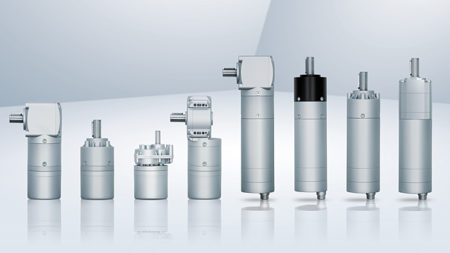For many years, ebm-papst Zeitlauf has been recognized for its expertise in the field of gear technology, particularly in the planetary gear segment (Performax and Noiseless series). These are noted for their exceptional performance and very smooth and quiet operation. In the industrial drive technology sector, market requirements in terms of engineering are currently developing in two directions. Firstly, the functionality of drive units needs to be extended in order to speed up the design and realization of the customer applications. Secondly, the power output within a given installation space needs to be increased further, particularly in the dynamic range. In order to be able to achieve this latter requirement, the necessary peak power in each individual module of a drive unit (gear head, motor, and electronics) must be significantly increased.
Requirements in terms of robustness and overload capacity

Figure 1: The Optimax 63 is a highly efficient planetary gear with high overload capacity.
This means, for electronically commutated internal rotor (ECI) motors, that higher starting torques are required together with simultaneously reduction of rotor inertia moments, in order that the dynamic response is significantly improved. This is a great challenge, particularly for the gear head. To meet the needs for higher output and mechanical robustness, specialist transmission suppliers place great emphasis on optimized design of the gear toothing and the output shaft bearing, combined with selection of the materials used. Both in terms of robustness and overload capacity, ebm-papst meets these requirements with the new Optimax series (Fig. 1). The first size of the series available will be the Optimax 63 gear head with an outer dimension of 63 mm.
This is where the many years of experience in gear tooth design for planetary gear heads really makes a difference. It is not just down to the teeth size (the “modulus”) or selection of the teeth ratios, the rolling behavior design of the gearwheels in the gear head is also critical. Due to the possible degrees of freedom in design of a gearing, the development engineer has, at the outset, a virtually unlimited number of potential approaches to a solution at his disposal. The skill lies in the ability to find the perfect “setting” within all these potential options.

Figure 2: Due to the four gears instead of the usual three, up to 30 % more torque can be transmitted.
The focus in the case of the Optimax, was placed on the requirements to withstand high continuous torques and a tolerance to transitory shock loads. In addition, it was also necessary to take a comprehensive view of the Optimax series and to structure it intelligently, both in terms of multiple use of components and a strategically favorable series of gear reductions (Fig. 2).
Four instead of three planetary gears
In order to be able to transmit as much power as possible, gear wheels with a very large width are fitted in the Optimax gear heads, which as a result, minimizes the surface pressure and wear on the tooth flanks, despite high torques, and in turn leads to a long service life. Another special feature of the Optimax gear head is the installation of four planetary gears, in a single gear stage, instead of the usual three. This allows some 30 % more torque to be transmitted, due to the power distribution over four planetary gears.
The Optimax gear head has four planetary gears in a single gear stage, instead of the usual three.
Using corner regions with installation space
The performance capability of a gear head, (i.e., the amount of torque that can be transmitted) will, of course, always be measured relative to its size and space requirement. This has also been taken into account in designing the Optimax gear head: With a near square cross-section, the flange size of 63 mm is best utilized with a large ring gear. The corner regions within the installation space are used for screwing the gear parts together. The gear head output shaft is mounted in two ball bearings; with particularly large bearing races for radial loads of up to 500 N (for a service life of 20,000 hours). Both flanges engage positively with the ring gear teeth, which ensures both the alignment of components relative to each other, and torque bracing among the casing components (intermediate flange, ring gear and casing flange). The function of the axial screws used, is therefore limited to bracing of the casing parts against each other.
The robustness and overload capability of the Optimax gear head, allows high acceleration and braking torques to be realized.
Almost all the parts in the Optimax gear head series are designed for a near net shape manufacturing process. By intelligent use of sintering, zinc die-casting and plastic injection molding technology, it has been possible to manufacture all the components at optimized costs and with the required properties: From noise-absorbing planetary gears made in plastic for the first gear stage, or alternatively high-strength planetary gears in sintered steel for use in the overload range; to a robust, wear-resistant ring gear made of hardened sintered steel and complex flange and casing geometries made as zinc die-castings with high dimensional stability.
Deviations from the standard design are possible

Figure 3: The table provides an overview of the different versions of the Optimax transmission with the associated data.
By using near net shape parts and production technology that has been perfected over many years, the gear heads can be offered at fully competitive prices, both for smaller batch sizes and for large series production. The materials and lubricants used allow operation over a wide temperature range (-20 to + 90 °C).
The standard version is offered with protection class IP 50, but higher protection classes up to IP 65 can be implemented by design and can be easily achieved by additional measures. Despite the high proportion of near net shape parts, a great deal of flexibility is still retained: deviations from the standard design are possible through the use of machined planetary and sun gears. Furthermore, output shafts can be adapted to the customer interface.
High acceleration and braking torques enables reduction in cycle times
The robustness and overload capability of the Optimax gear head, allows high acceleration and braking torques to be realized, which enables a significant reduction in cycle times for customer applications. The Optimax standard reductions, in the single-stage range, go from 3:1 to 5:1 (preferred type) and up to 9:1. The two-stage design is available with reductions of 15:1, 25:1 (preferred type) and 45:1 (Fig. 3).

Figure 4: As a result of the ebm-papst modular principle, the Customer can configure the drive system themselves. The transmissions offered in the Optimax 63 series can be combined with motors from the series ECI 63 and ECI 80.
The Optimax 63 series gear heads can be equipped with powerful, overload capable ECI 63 and ECI 80 series motors (Fig. 4). These drive solutions are characterized by high overload capacity and high output performance. In terms of functionality, compactness, overload capacity and efficiency, a drive unit based on the ECI 63 K4 motor and the Optimax 63 gear head should be more than capable of meeting any customer requirements.
Those interested to learn more can view the documentation for the new drive solutions (technical data, drawings, and 3D models) in the ebm-papst Zeitlauf online portal, and print or download them as required. Of course, the Optimax 63 preferred types are now included in the online portal and are ready for dispatch within 48 hours from receipt of order.

Leave a comment